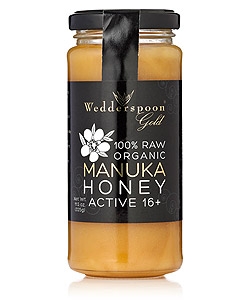The single most effective product I’ve used to treat my hormonal breakouts is Wedderspoon 100% Raw Organic Manuka Honey Active 16+ (as a mask or spot treatment). I leave it on for no less than 30 minutes; if I can, I’ll leave it on for a few hours while I’m cleaning up the house, working on the blog, taking care of the baby and generally solving the world’s problems. I rinse it off with warm water and I can immediately see a difference in my skin, but the effects are even more noticeable the next day: existing blemishes are less inflamed, less red and smaller. Blemishes that were broken are miraculously healed. My skin is softer, moisturized and more even. My pores look smaller. I’m not exaggerating. It’s crazy-good and tons of beauty insiders swear by it.
Cost: $40 for 11.5 oz. Purchase it here.
So, how does it work? Glucose Oxidase, an enzyme found in manuka honey, releases a natural form of hydrogen peroxide (a natural antiseptic) when applied to an infected site. This oxygenates pores, drawing out impurities and bacteria. Manuka honey is also high in antioxidants, which neutralize the free radicals that cause aging. Lactic acid in the honey gently exfoliates the skin and prevents scarring. However, unlike other masks, it will not irritate or leave skin overly dry, as manuka honey is a great humectant (it pulls in and seals in moisture) and it has a low pH. So, it’s pretty perfect for your pretty mug.
Aaaaand for the science nerds:
Manuka honey is produced in New Zealand by bees that pollinate the native manuka bush. All raw honey contains varying levels of the enzyme Glucose Oxidase. This enzyme, which is introduced into the honey by bees, will slowly release antiseptic Hydrogen Peroxide effectively into the site of infection, whether in or on the body, killing harmful bacteria without damaging body tissue.
However, manuka honey also contains an additional antibacterial component called methylglyoxal (MG). MG comes from the conversion of another compound – dihydroxyacetone – that is found in high concentration in the nectar of manuka flowers. MG is thought to give manuka honey its superior antibacterial power. The higher the concentration of MG, the stronger the antibiotic effect. When shopping for manuka honey look for a rating of at least MGO™100 or UMF®10+ if you are looking to fight a serious infection. In my experience, Active 16+ is plenty powerful when dealing with acne or a sore throat.
It’s so good at healing infection that in many hospitals around the world now, manuka honey is used when nothing else works for treatment of antibiotic resistant MRSA super bugs and Staphylococcus Aureus ( the most common cause of wound infection). Manuka honey also works wonders for eczema, dermatitis, burns, cuts, scrapes and burns.
…..
I’ve spent almost a decade immersed in the world of green beauty and nontoxic living. I want to help you find everything from a killer lipstick to a nontoxic laundry detergent, and beyond. Subscribe to a healthier lifestyle with me.

Thank you for subscribing!

